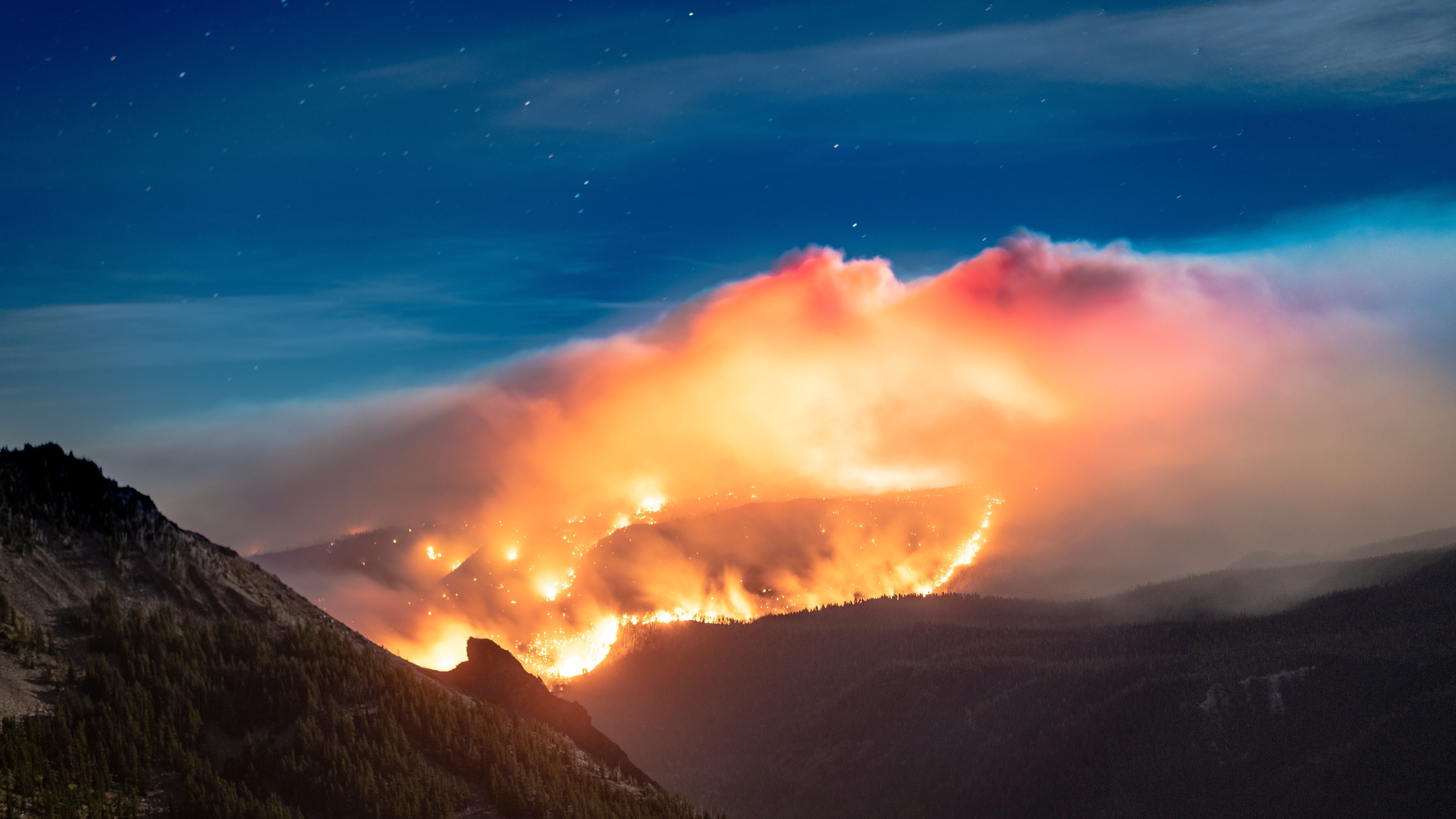Kathleen Becherer, 77, retired in 2014 to the Santiam River Canyon, where she hoped for a life filled with “bees, goats and grandkids.”
That dream was incinerated in September 2020. The Santiam Fire, which burned 400,000 acres (almost half the size of Rhode Island), reduced her riverfront home to ash and nearly killed her. Becherer spent more than two weeks in the hospital.
Memories of that night—the jet-engine roar of the fire, her goats too frozen with fear to flee the burning barn—remain. “I still get nightmares,” she says.
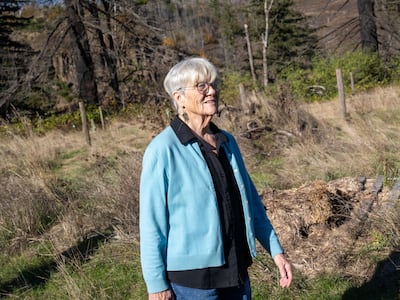
The Santiam tragedy was part of the worst wildfire year in Oregon history. It killed five people, destroyed hundreds of homes, and ravaged some of Oregon’s environmental treasures. It also cost the state hundreds of millions of dollars—not counting the health hazards that will linger for years. (Wildfires burned 1.9 million Oregon acres in 2024, eclipsing the 2020 record.)
Wildfires are Oregon’s most immediate existential crisis, creating economic, political and environmental challenges that state government is struggling to address. And the wildfires that recently destroyed parts of Los Angeles make clear this is not just an Oregon problem.
Although climate change and growing populations in forested areas are part of the reason for the threat, the role of electric utilities is also increasingly under the spotlight. Their transmission network of high voltage wires regularly causes fires—like the Eaton Fire that just burned Altadena, near Los Angeles.
Becherer and many of her neighbors in Gates and Detroit blame Portland-based PacifiCorp, the electric utility that serves much of rural Oregon, including the Santiam Valley, and is owned by Warren Buffett’s Berkshire Hathaway Energy.
Others are beginning to agree. In 2023, an Oregon jury found that PacifiCorp was reckless and acted with “gross negligence” in the lead-up to the 2020 Labor Day fires. The jury awarded damages that could eventually mean a $6 million payday for Becherer and each of the other 1,500 plaintiffs, which would make it the most costly litigation in Oregon history.
“The PacifiCorp litigation was a real sea change for the entire utility sector in the U.S.,” says professor Michael Wara, a utility expert at Stanford Law School. “PacifiCorp went to trial assuming they would win, and they definitely assumed they would not be held grossly negligent.”
And in December, the U.S. Department of Justice added to PacifiCorp’s legal woes. The feds filed a $900 million civil lawsuit, claiming the utility’s negligence caused a different 2020 fire in Southern Oregon in the Umpqua River Basin.
[ Federal Regulators Have Found Fault With PacifiCorp’s PracticesOpens in new window ]
Department of Justice lawyers said in the lawsuit that PacifiCorp and its subsidiary Pacific Power “have an established history of failing to satisfy basic safety standards and taking little action to remedy known safety issues.”
Despite the historic verdict, Kathleen Becherer has yet to receive any money.
She’s not the only one. In the aftermath of the Santiam Fire, PacifiCorp has waged a campaign, in the courts and now in the halls of the state Capitol, to reduce its financial obligation.
To be sure, forest fires shaped Oregon long before settlers arrived. But as the climate dries and fuel accumulates in the forests because of confusing state and federal policies, parts of rural Oregon become like tinder. And when utilities lag in their mitigation efforts, rural Oregon bears the brunt.
Reporting by the Oregon Journalism Project into the tangled aftermath of the historic 2020 Labor Day fires found:
- Long before the fires, state and federal regulators regularly clashed with PacifiCorp over the condition of its transmission grid and its slipshod execution of some of the most basic fire prevention steps.
- Prior to the 2020 fires, despite internal warnings and pleas from senior state officials, PacifiCorp never used its ultimate weapon against wildfire—a power shutoff. That decision has thrown PacifiCorp’s survival into question.
- The 2023 Oregon jury verdict on behalf of Santiam Valley residents has given way to a war of attrition. Despite the verdict in their favor, plaintiffs may not get any money for years. PacifiCorp has appealed and insisted on new trials for each individual fire victim to determine their damages.
- The fires have placed Oregon’s utilities at the center of a raging political debate taking place right now in Salem. As utilities grapple with growing demand from data centers and the push to green energy, anger at PacifiCorp in particular has done the near impossible—united conservatives and liberals who are fed up with the escalating cost of fire damage.
At the same time, Warren Buffett, who bought PacifiCorp in 2006, recently told shareholders his utility can’t pay for everything: “It will be many years until we know the final tally from forest fire losses and can intelligently make decisions about the desirability of future investments in vulnerable Western states.” Standard & Poor’s downgraded PacifiCorp’s credit rating in 2023 after the Oregon jury issued its stinging verdict.
“PacifiCorp’s No. 1 priority is the safety of our employees, customers and communities,” says utility spokeswoman Erin Isselmann. “PacifiCorp remains committed to effectively managing our system in the face of rising costs driven by wildfire risk, an increasing number of extreme weather events and a changing energy landscape.”
But now, OJP’s reporting shows, PacifiCorp wants to shift costs to Oregonians. What lawmakers do this legislative session will be consequential.
“PacifiCorp’s real hope,” state Rep. Jami Cate (R-Lebanon) says, “is that the Legislature will bail them out and effectively absolve them of any wrongdoing.”
One month before Oregon’s fateful 2020 wildfires began, OJP has learned, the Oregon Public Utility Commission (the state agency that regulates electricity providers) sent a prescient letter to top PacifiCorp officials demanding that the utility improve its vegetation management program.
Vegetation management is utility-speak for basic fire prevention measures. In Oregon, utilities are required to regularly inspect their power lines and remove or trim adjacent trees and shrubs. When the lines touch or even get too close to the surrounding vegetation, they can arc, sending out a shower of sparks. The heat can grow intense enough that power lines shoot out shards of molten metal.
In Oregon, PUC staff inspects power lines, in part to check on whether the utilities are diligent in their vegetation management.
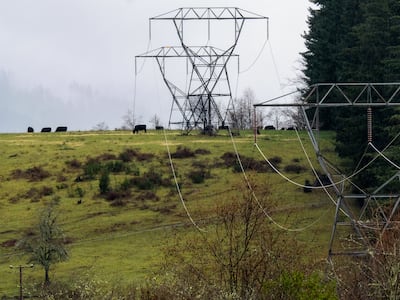
In the years leading up to the Labor Day fires, PUC staff grew alarmed at the “dramatic increase” of potential fire hazards its auditors found in Pacificorp’s transmission grid. In annual reports issued to the utilities, the PUC noted the number of problem spots quadrupled from 89 in 2011 to 373 in 2020.
“The long-term data shows the company’s vegetation management program is not adequately addressing the issue of tree contacts,” the PUC said in its July 23, 2020, letter. “The number of tree and energized primary conductor contacts are disturbing, considering the high-profile wildfire mitigation efforts in Oregon and the fire hazard in the Western United States.”
Six weeks later, the Labor Day fires ignited.
Barely three weeks after the Labor Day fires, the Portland law firm Stoll Berne filed a class action lawsuit against PacifiCorp on behalf of about 1,500 people who had lived through the Santiam Fire (a term that encompasses the Beachie Creek Fire, Lionshead Fire and several other conflagrations); the Echo Mountain Complex Fire in the Central Oregon Coast Range; the South Obenchain Fire in Jackson County; and the 242 Fire north of Klamath Falls.
The lawyers worked in uncharted territory. There wasn’t any authoritative narrative of what happened. And there still isn’t.
After deadly utility-caused fires in Washington, Utah and, most recently, Hawaii, officials in those states issued “cause and origin reports” within weeks. In Oregon, more than four years on, the state Department of Forestry has yet to release reports on any of the Labor Day fires.
The 2023 class action trial that took place in a Portland courtroom included excruciating testimony of deaths, injuries and destroyed homes, and an equally spirited defense from PacifiCorp.
The utility argued that climate change had wrought such profound and pervasive changes it would be unfair to hold one company responsible for fire damage.
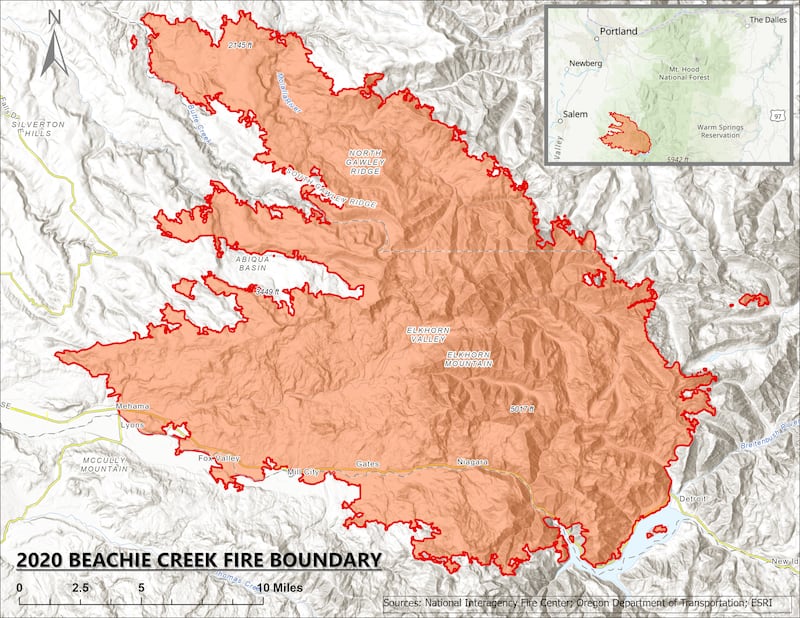
PacifiCorp also attributed much of the Santiam Canyon damage to the Beachie Creek Fire, a lightning-caused blaze that had been burning for nearly a month high in the Cascades between Mount Jefferson and Opal Creek. The intense winds pushed the fire westward toward the Santiam Canyon and Gates and sent red-hot embers flying over the area, some of which allegedly started other fires.
But plaintiffs called their own forestry expert, Oregon State University professor John Bailey, who argued just the opposite: The fires that did most of the real damage blew up thanks to hot power lines, with no help from the Beachie Creek Fire. “Beachie Creek was still miles away,” Bailey said.
Some observers saw the urban-rural divide play out in the courtroom. Freres Timber Inc., based in Lyons in Linn County, was among those suing PacifiCorp. The company said it lost 5,800 acres of timber in the fire, 687 acres directly attributable to PacifiCorp.
Company president Rob Freres Jr. says he found the trial eye-opening, particularly PacifiCorp’s disdain for fire victims. He points to the utility’s courtroom treatment of Rachelle McMaster, whose mobile home in the coastal hamlet of Otis was destroyed in another of the Labor Day fires.
“They belittled this woman and showed a picture of her mobile home with toys in the yard and a burn pile for their garbage,” Freres says. “They just characterized her as white trash. They didn’t use those words. But that’s what the implication was. And they turned off the jury so badly.”

Some of the most powerful testimony came not from victims but from a high-level political staffer.
In 2020, Nik Blosser served as chief of staff for then-Gov. Kate Brown. On Sept. 7, 2020, Blosser convened an urgent conference call with the state’s largest utilities about the risks of the Labor Day winds.
Blosser said in an interview with OJP that the call came about because Doug Grafe, the top wildfire expert at the Oregon Department of Forestry, insisted the state was in danger. Weather forecasts kept worsening, Grafe said. Forests were bone dry. And now, the National Weather Service was predicting intense winds from the east that could turn a spark into a conflagration.
Grafe led the conference call with executives from PacifiCorp, Portland General Electric, Idaho Power and the Bonneville Power Administration. In his distinctive Boston accent, Grafe briefed the company officials on the ominous forecasts.
What exactly was said next at the meeting is a matter of dispute. Blosser and Grafe both testified at the trial that the possibility of a Public Safety Power Shutoff was discussed. A power shutdown—essentially the deenergizing of power lines—is the ultimate weapon against power-line-caused fires.
(San Diego Gas & Electric pioneered Public Power Safety Shutoffs in 2008, and they are now used by utilities all over the West, including Oregon.)
The PGE official on the call, Dave Robertson, said in deposition that his company had already shut off the power in the Mount Hood corridor from Timberline Lodge to the cluster of small towns west of the mountain.
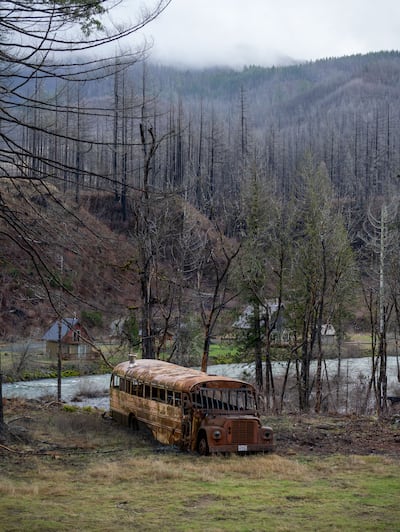
“PGE reported they were deenergizing some of their lines,” Blosser said at the trial and retold OJP, in his most detailed account of the meeting to date.
“PacifiCorp said they were not. After they said that, I asked, pointedly, if they were doing everything possible to avoid starting fires, because the fire chief was worried. The senior PacifiCorp official said they had done their weather modeling and were not going to deenergize—that they did not need to.”
Scott Bolton, PacifiCorp’s representative on the call, disputes Blosser’s and Robertson’s recollections. In an email exchange with OJP, Bolton, who left PacifiCorp in 2023, claims he was never asked for a power shutoff. “At no time did anyone from the governor’s office or anyone else on the call make a request to deenergize all or portions of any of the participating utilities’ systems.”
Bolton’s claim is at odds with others who were on the conference call.
PGE’s Robertson said in court and in a later interview that power shutdowns were a big part of the conversation that evening. Grafe “initially asked whether we could shut down everything in Western Oregon,” Robertson said. “I said we couldn’t do that. But if you give us specific locations, we can and will shut that down.”
Within hours, fires raged all over Oregon. Some of the largest and most dangerous burned in PacifiCorp territory. No major fires ignited in the Mount Hood corridor, PGE’s territory.
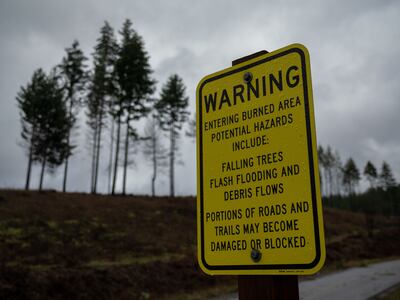
Blosser says he’s “lost many nights’ sleep” thinking about that call.
“We had the terrible weather forecast, we raised it to the highest levels of the utilities, and PacifiCorp had a chance to prevent disaster but inexplicably did not,” Blosser says. “And I will never understand why. The idea that they claim they weren’t ordered to turn the power off is absurdly feeble. It was totally clear what they were being asked. It’s a miracle more people weren’t killed by their tragic inaction.”
In 2024, Sokol Blosser Ltd., an Oregon winery owned by the Blosser family, joined a host of other wineries in a lawsuit against Pacificorp claiming their grapes were damaged by wildfire smoke. Nik Blosser does not work for the winery and does not play an active leadership role.
On June 12, 2023, after a seven-week trial, a Multnomah County jury found PacifiCorp was “grossly negligent” and reckless. The jury awarded about $100 million in damages to the first 17 plaintiffs, about $6 million apiece.
Jerry Singleton, a California lawyer who has sued PacifiCorp twice in recent years over its handling of two Northern California wildfires, wasn’t terribly surprised. “They don’t have a great record on safety; they are significantly behind many of the other utilities,” he says of PacifiCorp.
Two decades ago, PacifiCorp was an independent, locally based electric company with 10,000 employees. It had deep roots in Oregon embodied by the civic engagement of its longtime chairman Glenn Jackson. Upon his death in 1980, The Oregonian wrote, “Jackson probably devoted more voluntary service to Oregon than any citizen before or since statehood.”
Today, the utility’s center of gravity has shifted to Omaha, and its executives keep a lower profile in Oregon. In the past 10 years, PacifiCorp has sent $4.3 billion in dividends back to Buffett’s Omaha headquarters. Meanwhile, the utility’s ranks have fallen by half to 5,000 workers.
When PacifiCorp lost the 2023 verdict, it quickly appealed to the Oregon Court of Appeals and convinced the trial court to hold separate proceedings for each remaining individual plaintiff to determine damages. That could take years.
The plaintiffs, many of whom lost their homes and personal belongings, are bitterly disappointed by the delay.
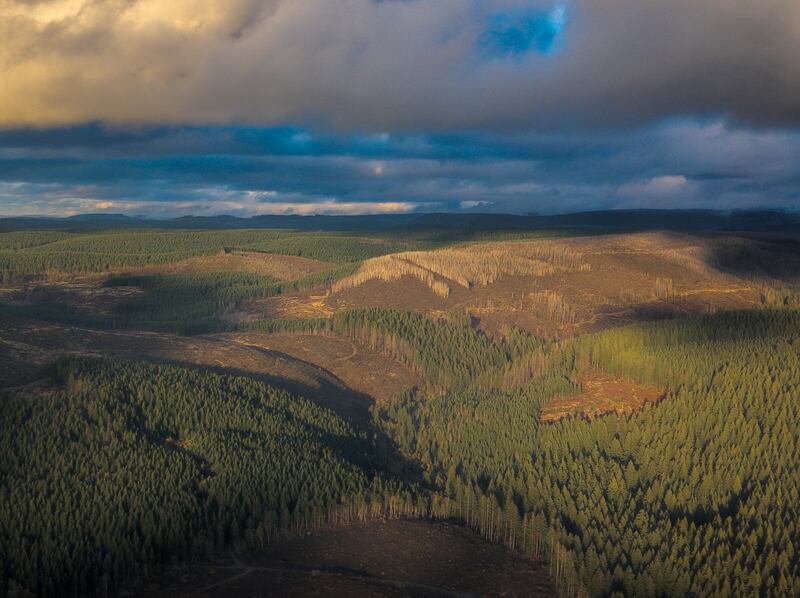
“If somebody stole something from you, they would pay the consequences and they would pay now, not when it’s convenient for them,” says Chris Grom, a Gates resident whose house burned. “They caused this fire. We proved it. Make them pay.”
PacifiCorp declined interview requests but did provide some answers to written questions. The company said it has spent $1.1 billion since 2020 making its transmission system less likely to start fires. And while denying any wrongdoing, it has paid another $1.2 billion to settle other legal claims stemming from the Labor Day fires, including those by 876 Oregon claimants.
The utility also said it has implemented Public Safety Power Shutoffs four times since the 2020 fires. But it declined to answer why the company didn’t deenergize its power lines in September 2020.
While PacifiCorp’s appeal continues, an equally important campaign is gearing up in Salem. Although it is still early, lawmakers on both sides of the aisle have introduced a number of bills relating to wildfire costs and who should pay.
Some lawmakers want to create a billion-dollar wildfire fund, bankrolled by utilities and ratepayers, to compensate fire victims, says state Rep. Pam Marsh (D-Ashland). “We are living in a time of wildfire, and the risks are overwhelming,” Marsh says. “We need the utilities to be there.”
Another pending bill would create a separate funding stream of at least $140 million annually to mitigate and fight fires.
For its part, PacifiCorp is seeking legislation that would cap its liability for fires (in 2024, the utility convinced Utah lawmakers to limit its liability to $450,000 per person).
State Rep. John Lively (D-Springfield), who chairs the House Climate, Energy and Environment Committee, says lawmakers are serious about tackling the causes and impacts of wildfires.
“These are huge issues,” Lively says. “It’s clear we can’t continue operating the way we’ve been operating.”
Fred Heutte, senior policy adviser at the NW Energy Coalition, a green energy advocacy group, says, “There’s a lot of money and a lot of risk on the line.”
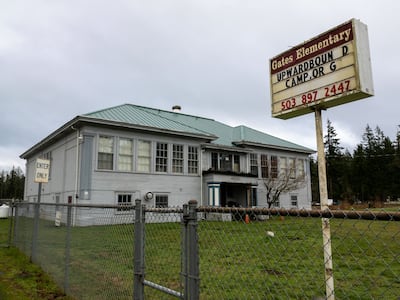
It’s a volatile issue that transcends typical partisan lines. Cate, the Lebanon representative, and two other House Republicans are sponsoring a bill “that would prohibit any rate hikes for any utility provider if it has unresolved wildfire liability lawsuits for more than three years.” (PacifiCorp recently raised its residential rates by 8.6%, according to the PUC.)
Senate Minority Leader Daniel Bonham (R-The Dalles) says in his experience that investor-owned utilities like PacifiCorp “keep loading costs on ratepayers, many of whom can’t afford it. Ratepayers are getting left in the dust.”
Some Democrats, including Sen. Khanh Pham of Portland and Rep. Mark Gamba of Milwaukie, want the PUC to change the way utilities get compensated. Instead of being granted a nearly guaranteed return on investment (the reason a savvy investor bought PacifiCorp), lawmakers want utilities to have to meet rigorous performance standards to get paid.
State Rep. Ed Diehl (R-Scio), a staunch conservative, finds himself in agreement with liberal Democrats on the need to push PacifiCorp to treat ratepayers—and the victims of the 2020 fires—better.
“They are dragging their feet,” Diehl says. “I want to see them do the right thing.”
And where is Gov. Tina Kotek? She is not yet saying what her position is.
When Kathleen Becherer and her husband, Bruce Bailey, fully realized what was happening that early morning of Sept. 8, fire was roaring down the Santiam right toward them. Smoke was in their house. Heat and wind shattered windows.
Becherer ran to open the barn door for her herd of 20 goats. But the barn was already on fire.
Becherer’s skin cooked in the heat. She left the goats and ran for her life.
Meanwhile, the howling east wind had blown several trees across their driveway. There was no way out.
With their driveway blocked, they couldn’t get to the main road. So Bailey and Becherer drove the Jeep through pasture for almost a quarter mile, far from trees. Bailey drove more by feel than sight. “At that point, it was impossible to see,” he says. “I couldn’t see farther than my feet.”
Neighbors found them the next morning, still alive, hunkered down in the Jeep. Their house was gone, as were five outbuildings. Rescuers came and Becherer was taken to the burn center at Legacy Emanuel Medical Center in Portland. Over the subsequent two weeks, she underwent multiple skin graft operations on her legs, hands and face.
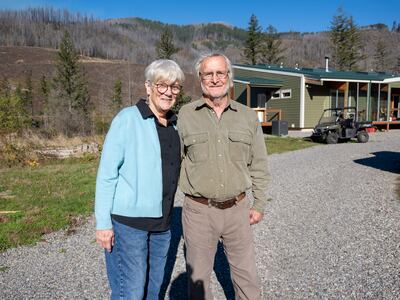
The couple lived in a series of hotel rooms, RVs and tents over the next four years, waiting for their new, more fireproof home to be built. Rebuilding drained their finances, Becherer says, and relying on tents and a porta-potty in their 70s drained their morale.
Though they try not to dwell on it, their anger at PacifiCorp is never far from the surface.
So while Becherer survived the firestorm, the question that nags at her is whether she will live long enough to collect her legal damages.
Thirty of the plaintiffs have died since the case began, attorneys say, without receiving any funds.
“I’m pretty resilient,” Becherer says. “I like people, but I don’t like Pacific Power. It’s been four years, for God’s sake.”
Correction: This story originally misstated the frequency with which the Public Utility Commission notified PacifiCorp of vegetation management shortcomings. Oregon Journalism Project regrets the error. The story has also been updated to include context about a lawsuit filed last year by Nik Blosser’s family’s winery.
Nigel Jaquiss contributed reporting to this story.
This story was produced by the Oregon Journalism Project, a nonprofit newsroom covering rural Oregon. OJP seeks to inform, engage, and empower readers with investigative and watchdog reporting that makes an impact. Our stories appear in partner newspapers across the state. Learn more at oregonjournalismproject.org.
